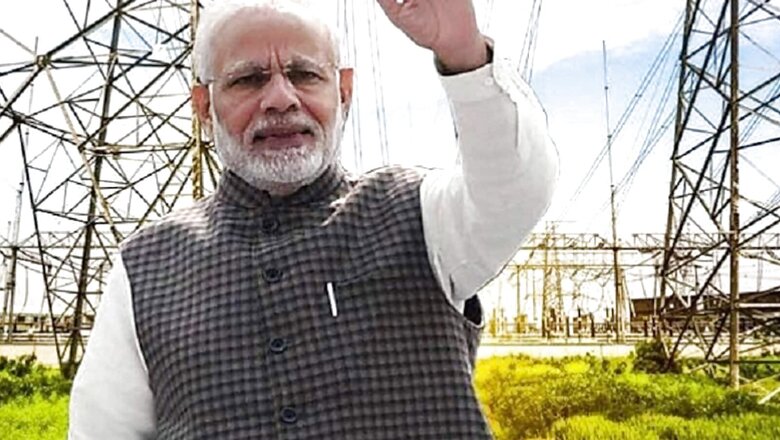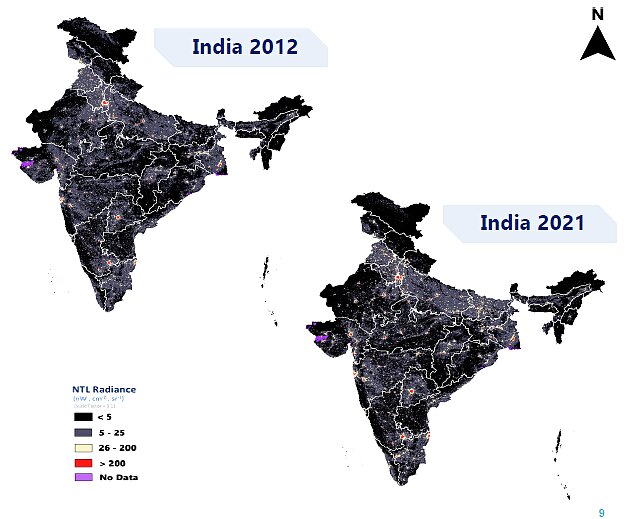
views
Did the electrification of nearly three crore households in India since 2017, under the Saubhagya scheme, and the construction of almost 50,000 km of national highways since 2014 contribute to the increase of 43% in Night Time Lights (NTL) in India over the past decade?
Two senior government officials told News18 that these could have been major factors with electricity, and specifically LED bulbs under the Ujala scheme, reaching every household, and the lit-up national and state highways contributing to India shining bright in the luminosity data analyzed by the Indian Space Research Organization (ISRO).
The data is often considered an indicator of the growing economic activity and for assessment of developmental patterns which can be co-related with infrastructure development, says the ISRO report on the decadal-trend analysis carried out by the Hyderabad-based National Remote Sensing Centre (NRSC).
Scientists have studied the change in luminosity at the national, state and district level from 2012-to 2021 captured by satellites, reporting a 43% jump for the country in overall NTL from 2012 to 2021. A significant increase was reported in the big states of Bihar (from 8.36% to 47.97%), Uttar Pradesh (26.96% to 43.5%), Gujarat (20.69% to 32.68%) and Madhya Pradesh (8.99% to 14.95%) and in Manipur, Kerala and Ladakh. India’s overall luminosity increased from 17.53% in 2012 to 22.96% in 2021, as per the ISRO report.

IMPACT OF SCHEMES?
The Modi government had launched Pradhan Mantri Sahaj Bijli Har Ghar Yojana – ‘Saubhagya’ — in October 2017 with the objective of achieving universal household electrification, by providing electricity connections to all unelectrified households in rural areas and all poor households in urban areas in the country. All the households in the country were reported electrified by the states, with 2.8 crore households electrified since the launch of Saubhagya, up to March 31, 2021. Further, the Centre undertook the ‘UJALA’ scheme in 2015 to distribute 36.78 crore LEDs distributed across the country, which may have contributed to luminosity.
The record construction of National Highways in the country since 2014-15 could be another reason for higher luminosity of India. India now has the second largest highway network in the world at a total of 63.73 lakh km. While the total National Highway length in India stood at 97,830 km in 2014-15, it currently stands at nearly 1.45 lakh km, with highways being built at nearly 29 km/day now. This speed stood at 12 km/day in 2014, data shows.
There is a provision for lighting on NHs at built-up sections, toll plaza areas, rest areas, truck lay-byes, bus bays and bus shelter locations, grade-separated structures, interchanges, flyovers, underpasses (vehicular and pedestrian) and overpasses.
WHAT ARE NIGHT TIME LIGHTS?
Night Time Lights are basically the visible lights emitted from the earth and as captured by satellites from space. They are generally a representation of human activities, which have been used by experts to assess the developmental patterns in a region over a period of time. However, the co-relation may not be direct.
The most marked increase in India was observed between 2012 and 2020, after which there was a 5% slump during the pandemic year 2020. This was mostly due to the economic downturn and the prolonged pandemic which led to a temporary shutdown of various economic activities, workspaces as well as small businesses.
The scenario improved starting 2021, as the data shows. According to the analysis, there was a 9% rise in the luminosity data for the country from 2020 to 2021. “These radiances can be correlated with infrastructure development, economic growth and the impact of the pandemic like Covid-19," says ISRO chief S Somanath in the national-level Atlas prepared by the scientists.
BIHAR RECORDS HIGHEST INCREASE, FOLLOWED BY MANIPUR, LADAKH
However, the most significant increase was observed in Bihar, where the cumulative radiance compared to its geographical area went up by a staggering 474% from 2012 to 2021. Most prominent changes were observed in Patna, Jhanabad, Vaishali and Siwan, as per the analysis. States which show more nightlights are often considered to have higher economic output, however it can only be seen in light of other development activities on the ground.
Apart from Bihar, the most drastic improvement was seen in the far-end states of the country –Manipur, Ladakh as well as Kerala. While Manipur showed a 441% increase, it was 280% for Ladakh and almost 119% for Kerala.
28th April 2018 will be remembered as a historic day in the development journey of India. Yesterday, we fulfilled a commitment due to which the lives of several Indians will be transformed forever! I am delighted that every single village of India now has access to electricity.— Narendra Modi (@narendramodi) April 29, 2018
Chhattisgarh, too, showed a 12% increase during the period, especially in Raipur, Durg, Raigarh and Jangir Champa. There was a good increase in luminosity in Arunachal Pradesh (66%), Madhya Pradesh (66%), Uttar Pradesh (61%) as well as Gujarat, where it rose by nearly 58% during the past decade, as per data.
The changes in luminosity were moderate in other states and union territories, including Lakshadweep, Maharashtra, Tamil Nadu, Jharkhand, Haryana, Punjab, West Bengal, Uttaranchal, Karnataka, Odisha, Telangana, Andhra Pradesh, Nagaland, Chandigarh, Himachal Pradesh, Rajasthan, Tripura, Goa, Chhattisgarh, Assam, Andaman and Nicobar, Meghalaya, Jammu & Kashmir.
The analysis emerges from an analysis of the night time data from the VIIRS/DNB – combined mission of the US-based National Aeronautics and Space Administration (NASA) and National Oceanic and Atmospheric Administration (NOAA). Their weather satellites – Suomi NPP launched in 2011 and NOAA-20 in 2017 — can acquire night time lights even in poor illumination conditions.
Read all the Latest India News here




















Comments
0 comment